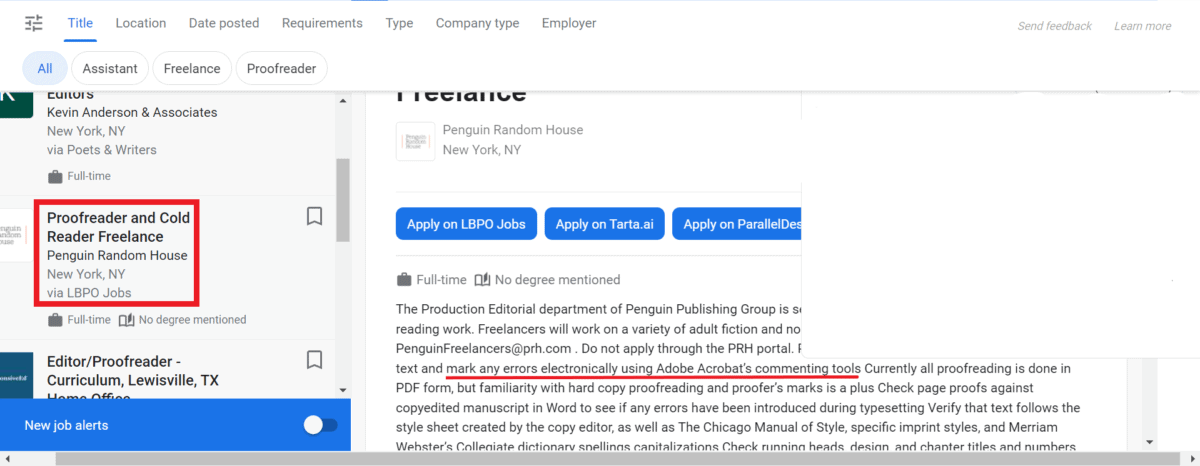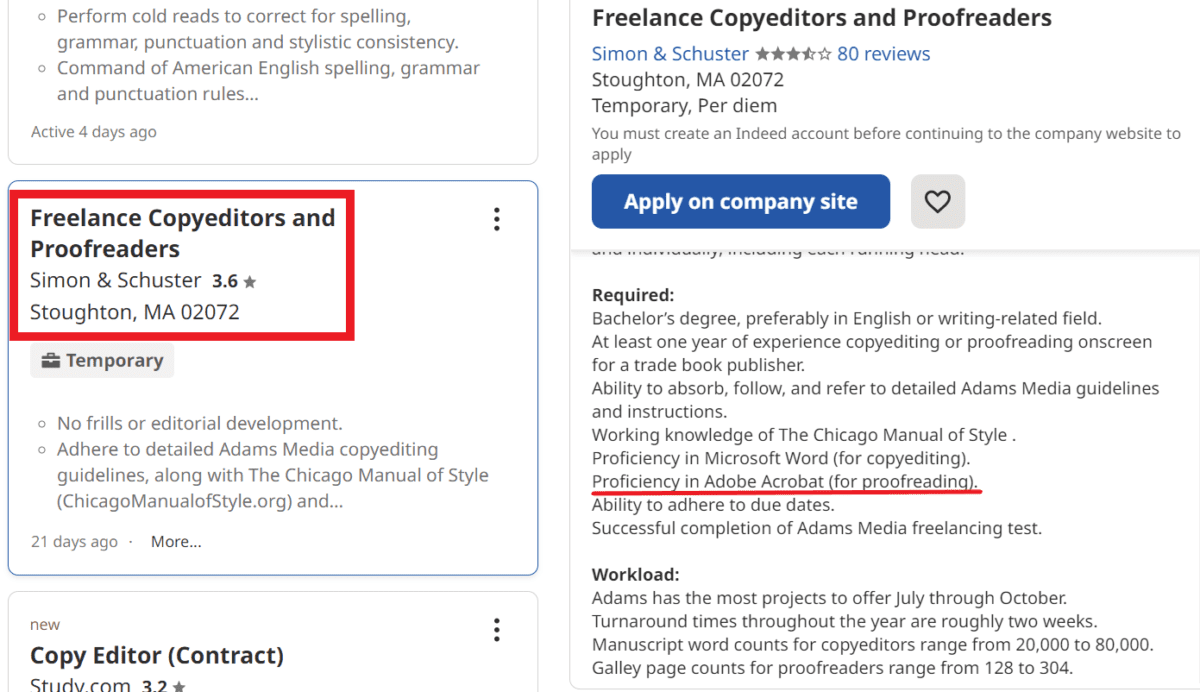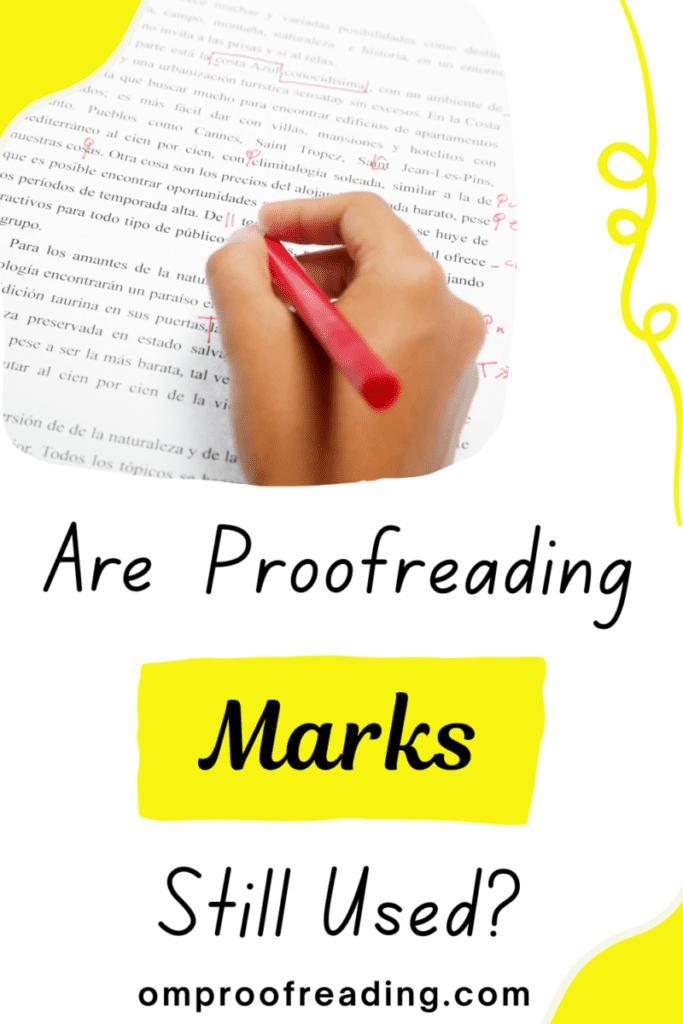This article may contain affiliate links. Please see our affiliate disclaimer in the footer menu for more information. Thank you for your support!

Suppose you have a document needing proofreading, or you’re considering becoming a proofreader. In that case, you may wonder if proofreading marks (aka proofreaders’ marks) are still used, considering the amount of information published digitally.
Proofreading marks are still used occasionally, but they’re employed far less frequently than in the past. It is becoming increasingly common for proofreading to be done digitally using Microsoft Word’s Track Changes, Google Docs’s Suggesting feature, and PDF markup software like Adobe Acrobat.
As someone who works in the proofreading industry, I can explain the extent to which these symbols are employed. I’ll also let you know if you need to learn about them—whether you plan to become a proofreader or have a text needing proofreading.
We’ll also examine why proofreaders’ marks are becoming less common.
Are Proofreading Marks Still Used?
We know that proofreaders’ marks are now used much less often than in the past.
To better understand how often proofreading marks are still used, I went on Google and Indeed (a popular employment platform) to look at the job requirements of numerous job postings for proofreaders.

I saw a couple of posts from two of the most well-known book publishing companies: Penguin Random House and Simon & Schuster.
I also checked the best proofreading courses on the market to see whether they taught proofreaders-to-be about these abbreviations and symbols. I knew that would be another good indication of how frequently these marks are still used in the field.
But before we delve into the current use of these marks, let’s clarify what they are.
What are Proofreaders’ Marks?
Proofreading marks are symbols that show how to correct minor mistakes in printed documents. A proofreader usually uses a red pen to write these notations within sentences and in the margins of pages. Their use ensures that writing is as polished as possible prior to publication.
Of course, red is used since it’s easy to see against the black letters on a page.
Imagine if a proofreader used navy blue proofreaders’ marks to point out errors in a text. What a headache for the poor writer or typesetter trying to wade their way through barely visible corrections!
Hopefully, red ink doesn’t bring up too many bad memories for people.
I remember getting a few essays back from teachers where it seemed like there was more red ink than black. 😉
Proofreaders’ marks were a much-needed creation because proofreaders needed an efficient and practical way to mark up printed copies without taking up too much space on the page.
If you’d like to know more about how we think about proofreading in the publishing industry versus how we think about it in other fields, feel free to check out my article about proofreading.
Is Knowledge of Proofreading Marks a Job Requirement for Proofreaders?
Occasionally.
Most job listings I saw did not require proofreaders to know proofreading marks.
The majority of businesses wanted their proofreaders to be familiar with Microsoft Office, particularly MS Word.
And if the company needed a proofreader for typeset documents, they wanted them to be familiar with Adobe Acrobat. Adobe Acrobat is software used to edit PDFs.
Here’s a screenshot of a job posting from a branch of Penguin Random House—one of the most well-known publishing companies.
As you can see, they tell us that proofreading is done in PDF form. However, they then mention that knowing how to proofread hard copies with “proofer’s marks” is a plus.

And here’s a posting from Adam’s Media, an imprint of Simon & Schuster. Simon & Schuster is another big name in the publishing industry.

So if you work in-house as a proofreader, especially at a publishing house that produces typeset documents, you’ll probably use Adobe Acrobat software to mark up PDFs.
However, you may be required to proofread on paper using standard proofreading marks.
This is especially common in small publishing companies that have been around for a while. These companies may not want to update their technology or simply prefer to stick to how they’ve always done things.
Furthermore, you may need to be familiar with these symbols since they’re the foundation for the software created to mark up PDF files.
As mentioned, it’s far more common for proofreading to be done digitally.
Nonetheless, here’s an example of a company that wants its proofreader to have knowledge of proofreading symbols.

As a freelance proofreader for individual clients, I can tell you the number of times a client has asked me to use proofreading marks: zero.
I will say, though, that I may never have been asked to use them because I prefer to work on short texts. Proofreading marks are more likely to be used with books since books are often available not only digitally but also in print.
So you will still find freelance proofreaders who use these symbols to mark up book manuscripts. But this is the exception, not the rule.
If You Hire a Proofreader, Do You Need to Know Proofreading Marks?
If you have a piece of writing that needs proofreading, you won’t need to know anything about proofreading marks.
Most people have no idea what these glyphs mean.
You’ll just need to know how to review corrections the proofreader has made with Track Changes in Word or the Suggesting feature in Google Docs, depending on which software you used for your writing.
And if you happen to have a PDF, your proofreader will use software like Adobe Acrobat.
Do the Best Proofreading Courses Teach Proofreading Marks?
I wrote an article about the best proofreading courses on the market. Two of the four classes in that post teach proofreading marks, and two don’t. Why the difference?
The two courses that don’t teach them—courses by Proofread Anywhere and Knowadays—are the two most recently designed courses.
They consider that most proofreading is done digitally nowadays, and most proofreading jobs won’t require knowledge of proofreaders’ marks.
“We don’t teach the use of proofreading symbols, as most proofreaders today are unlikely to use them. There may be some clients who prefer the traditional methods of proofreading, but most work will be done digitally.”
– Knowadays
The two programs that teach proofreading marks—The Chartered Institute for Editing and Proofreading (CIEP) and The Publishing Training Centre—consider that they’re still used occasionally, especially at publishing houses.
Both organizations teach BSI (British Standards Institution) proofreading symbols.
Being familiar with these symbols certainly doesn’t hurt.
I can understand the justification for both excluding them from and including them in the class material.
Why Are Proofreaders’ Marks Becoming Less Common?

The creation of software like Adobe Acrobat has made it much more efficient to proofread typeset documents digitally (as PDFs) than by hand.
And although many proofreaders swear they can find more errors when proofreading a paper document, using PDF markup tools has the following advantages:
- Clicking on premade symbols is faster than writing them.
This saves the proofreader a ton of time!
Imagine the care a proofreader needs to take to clearly write these tiny symbols on a crowded page.
- Typed annotations are far easier to read.
- Annotations and comments are searchable.
PDF software allows users to scroll through all the corrections and search for corresponding comments.
- Lengthy comments can be made on the relevant page using pop-up boxes.
If a proofreader needs to make a lengthy comment on a printed page, they may not have sufficient space. If this is the case, they’ll have to attach another piece of paper.
But PDF software allows comments to be made in pop-up boxes that overlay the text.
You can open and close them with a click.
- The turnaround time is much shorter (no snail mail necessary).
Doesn’t snail mail seem to take such a long time these days, lol?
- There are no shipping costs.
You can’t beat free.
Since digital proofreading has so many advantages, it’s plain to see why proofreading marks are falling by the wayside.
What Are the Commonly Used Proofreading Marks?
The commonly used proofreading marks for US English are divided into three categories: operational signs (primarily for indicating formatting issues), typographical signs (mainly for specifying the proper font), and punctuation marks (for showing missing punctuation).
Soon, I’ll give you a link to check out the proofreaders’ marks from the 18th edition of The Chicago Manual of Style (CMOS).
You’ll see how each symbol falls under one of the three major categories of proofreading marks: operational, typographical, and punctuation.
Although some organizations establish in-house proofreading marks for the documents they work with, you’re going to see the complete set of symbols that are standard across the publishing industry in the United States.
Ready to check them out? Here they are! 😊 You’ll notice that the meaning of many of them is fairly intuitive.
And below is an excellent two-minute video by Reedsy that shows some of the most common proofreaders’ marks and meanings.
My favorite version of these special symbols was created by Grant Snider of Incidental Comics. If you want a good laugh, I encourage you to check them out. I think they’re brilliant!
How Do You Use Proofreading Marks?
Proofreading marks are usually made with a red pen and placed in the text in the exact spot where the correction needs to be made. Each carefully written mark is also placed in the left or right margin, in line with the corresponding line of text.
Let’s see what CMOS says about placing marks within the text and in the margins.
“Never should a correction be written or marked only between the lines where it could be missed.”
Source: The Chicago Manual of Style
If a line needs more than one correction, the proofreader should write the marks in the margin in the order in which the errors occur. A vertical line should separate the symbols.
Why Are Proofreading Marks Important?
Proofreading marks are important because they simplify the process of proofreading hard copies. These symbols allow the text to be marked up clearly, let proofreaders work faster, and provide all parties (proofreader, author, typesetter, etc.) with one set of standard marks.
Each page needing to be proofread already contains a lot of text, leaving little room in the margins for corrections.

But this is a good thing! Think about how much paper we’d waste if we didn’t do a good job of utilizing the space on pages in books, magazines, newspapers, and any other kind of publication.
We don’t want to speed up the process of deforestation!
Therefore, having this shorthand code enables the proofreader to demonstrate how to fix an error without having to write out any words.
Proofreaders can also work more quickly since they won’t have to write out a brief explanation for every error they find.
For example, instead of writing “capitalize the word december,” they can simply draw three short lines under the lowercase d. Pretty handy! 😊
Should All Documents Be Proofread?
No, not all documents need to be proofread. However, to the extent that proofreading would improve the reading experience for someone else or help them focus on your message instead of your mistakes, proofreading should be considered.
You can contemplate varying degrees of proofreading according to the text in question.
For example, your diary doesn’t need proofreading. But if you find yourself proofreading it anyway, you’d probably make an excellent proofreader! 😊
However, if we’re talking about an email you’re going to send to your boss, you’ll likely want to give it at least a once-over.
And if you have a business document that a large audience will see, you’ll want to spend some time proofreading it and strongly consider hiring a competent proofreader.
Finally, if we’re talking about a text like a master’s thesis, you’ll want to hire a proofreader to polish your writing to a high standard.
So whether a text should be proofread (and to what degree) depends on the kind of document in question.
I hope this article has given you a good idea about the extent to which proofreading marks are still used.
Best wishes to you!
“Be a lamp, or a lifeboat, or a ladder. Help someone’s soul heal. Walk out of your house like a shepherd.”
– Rumi

Recent Posts
Punctuation is important because it enables us to communicate our message clearly and effectively. Without punctuation, we wouldn’t understand how units of a sentence relate to one another or how...
Although you're probably somewhat familiar with adverbs, you may be unaware of sentence adverbs. As a trained proofreader who has studied the parts of speech, I can help you understand this unique...
